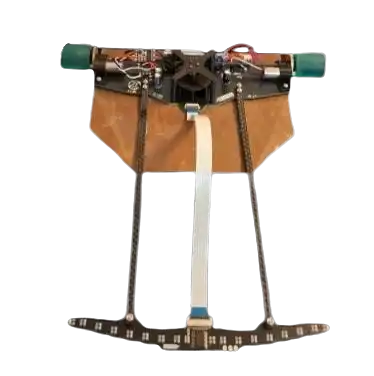Short description
Robots must follow a marked line from start to finish in the shortest possible time while staying fully autonomous.
1. General requirements
1.1 Size & weight limits
- Max footprint: 250 × 250 mm; max mass: 1000 g.
- Prohibited: sticky substances to boost traction. Any contact surface must not pick up and hold an A4 sheet (80 g/m²) for more than 2 s.
- Visible competition number (provided by organizers) on the outer casing.
- Robot may be equipped with an EDF/turbine and may use it.
1.2 Course time
Timing starts when the forward-most part crosses the start line and stops when it crosses the finish line.
1.3 Time limits & phases
- Per-attempt cap: 3 minutes to complete the course.
- Qualification block: 180 minutes total during which each robot must complete 3 attempts. After a 10-minute break, eliminations begin with the best 8 / 16 / 32 robots.
1.4 Timekeeping
Electronic gate or referee stopwatch may be used; recorded times are final. Final classification uses each robot’s best time.
1.5 Autonomous control
After crossing the start line, the robot must remain fully autonomous. Touching the robot is forbidden except to stop it if it exits the competition area.
1.6 Aim of the game
Follow the course line accurately from start to finish, as fast as possible.
Important: One person may operate a maximum of 2 robots.
1.7 Attempt window & queue rules
- Total window: 90 minutes (may be extended by organizers).
- First half: every participant must log at least one run. Priority to robots without a time.
- Second half: unlimited attempts as permitted by queue/referee.
- Best time per robot counts.
- Teams must follow room/waiting-area protocols and schedule. PLEASE DON’T BE LATE — WE WILL NOT WAIT! If called and you do not arrive within 5 minutes, the robot is disqualified.
1.8 Losing the line
- If the robot loses the line, it must restart from the start position.
- If it loses the line a second time in the same attempt, the recorded time is 3:00.000.
- Each attempt is entitled to one restart for line loss.
1.9 Course specifications
- Course on a white rectangle with a black 15 mm line.
- Start/finish line and electronic timing gate present.
1.10 Line characteristics
- Crossovers may exist (line can cross itself).
- Switchbacks/hairpins possible; adjacent line sections ≥ 15 cm apart (center-to-center).
- Distance from line center to arena edge ≥ 15 cm.
- Minimum curve radius: 7.5 cm.
- Sharp angles ≥ 90°.
1.11 Power of officials
Officials’ decisions regarding rules and conduct are final.
2. Homologation (technical inspection)
- Size check with a bottomless 250 × 250 mm frame.
- Weighing: ≤ 1000 g.
- Traction test: A4 sheet must not remain attached > 2 s.
- Robot is not restrained after homologation.
- Queue protocol: first approved team remains in waiting area; others return to their rooms.
- Verify visible competition number.
3. Declaring objections
- No objections may be made against judges’ decisions.
- The team lead may raise procedural doubts with the Committee before the match ends; if no Committee member is present, raise them with the judge before the match ends.
- Regulatory matters, complaints, or serious misconduct will be discussed with the Relativity Robotics Challenge organizers or the referee.
4. Flexibility of rules
As long as core concepts are preserved, organizers may adjust rules (format, timing, etc.) provided changes are published prior to the event and applied consistently.
5. Liability
- Teams are responsible for the safety of their robots and any incidents caused by their members or robots.
- The Relativity Robotics Challenge organization and staff are not responsible for incidents/accidents caused by participating teams or equipment.
Addendum 1
-
Robot Identification Numbers – Unique numbers assigned to each robot.
-
Participation Certificates – Diplomas awarded to all participating teams.
-
Team Member Badges – Identification badges for all team members.
-
Team Room and Competition Area Information – Details regarding assigned team rooms and a map of the competition areas.
-
Promotional Materials – Flyers, brochures, and other informational or marketing items.
-
Group Formation Guidelines – Instructions and criteria for forming teams or groups.
-
Maps of Team Rooms and Competition Areas – Detailed layout maps to navigate team rooms and competition zones.
